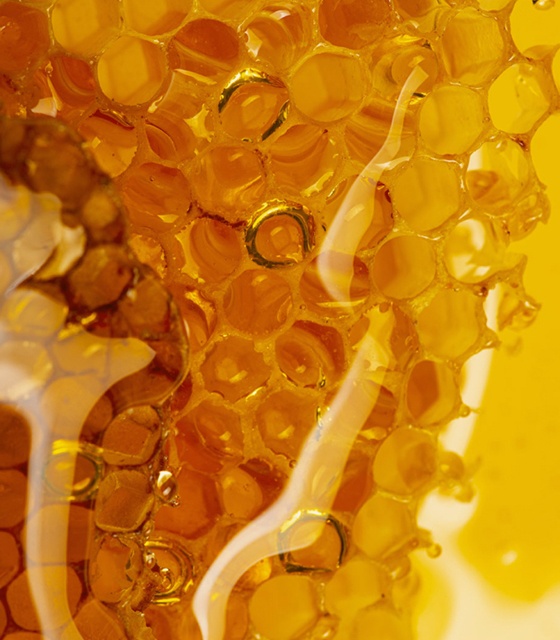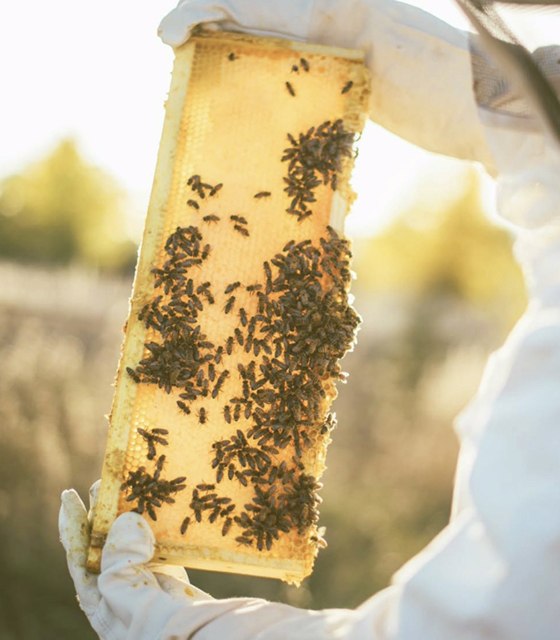Honey has been valued and the collecting of honey honoured by civilisations for millennia – but unique New Zealand mānuka honey's health properties are recognised worldwide and sought out as an incomparable, delicious, natural health food.
Uses, benefits & UMF™ quality certification
New Zealand’s Unique Mānuka Honey

What is Mānuka honey?

Functional food rather than honey, New Zealand’s unique Mānuka honey truly is the golden standard against which other honey and natural health foods are compared. Discover the uses, benefits, and UMF™ quality certification of Aotearoa New Zealand’s own superfood.
Delicious, thick, and with a characteristic cream to caramel colour, mānuka honey has long been admired as a unique honey with a delicious flavour and health attributes unlike any other honey in the world.
Mānuka honey is produced from the characteristic nectar from the sweet-smelling flower of the mānuka tree. Rich in amino acids, Vitamins B & C, antioxidants, minerals, proteins, carbohydrates, and bioactive compounds, mānuka honey is a superfood and is at the forefront of natural health sciences. Few other natural products compare with the complexity of natural components at work in New Zealand mānuka honey to deliver antibacterial, antioxidant, anti-inflammatory, immunomodulatory and anti-fungal properties.
What Makes Mānuka Honey Special?

Authentic manuka honey is unique to New Zealand. It starts with the special mānuka tree (Leptospermum scoparium) and its remarkable flowers. 2023 research showed there is no other plant like it in the world.
Research from the University of Waikato published in New Phytologist has revealed that the nectar-producing parts (or ‘nectaries’) of the mānuka flower produce an unusual nectar that bees transform into mānuka honey.
Mānuka trees are capable of photosynthesis not just in their leaves as other plants do, but their nectaries too – producing the nectar sugars and other valuable ingredients that give mānuka honey its unique potent properties called the ‘Unique Mānuka Factor™’ or UMF™.
Through the Manuka ID project, the UMFHA led research that identified more than 2000 natural components in manuka honey indicating it is significantly more complex than 11 other well-known kinds of honey. Among those components identification and understanding of the potential methylglyoxal and leptosperin are progressing rapidly and
The remarkable properties of the mānuka tree and its nectar have been understood by New Zealand’s indigenous Māori population for almost a millennia. The importance of mānuka features in the role it has had for centuries a traditional remedy and its importance is even recognised in Māori creation stories.
Applications

Consuming and Using Mānuka Honey
Consumed in at least 60 countries around the world, New Zealand mānuka honey lovers have created their own ways of incorporating mānuka honey into their routines to support a healthy lifestyle.
Most popular may be enjoying it straight off the spoon closely followed by adding a spoonful to a favourite tea or even hot water. It is used as a natural sweetener, particularly for a healthy cereal topping, added to smoothies, or anytime you want a delicious boost to your breakfast.
Mānuka honey is used in many countries as a natural skincare either directly on the skin, blended into a natural skin cream or as an ingredient in a store bought skincare product (always look for the UMF™ quality mark).
Whether sucking on a lozenge, a lollipop or savouring a dollop on the tongue mānuka honey is well recognised for soothing sore throats and easing coughs.

Understanding NZ Mānuka Honey
Research into the potential applications for mānuka honey is ongoing with hundreds of published scientific papers on record.
Initial research identified early its development the potential applications for mānuka honey to support wound care. Research has led to a category of products in this area that ranges from ointments to bandages infused with mānuka honey.
Research has progressed and the role of the compounds methylgloxal (MGO) and leptosperin in particular have attracted attention in laboratory research.
We now know that when consumed, leptosperin crosses the gut into the bloodstream confirming the potential for it to be a natural support for health and wellness.
Laboratory Research
Three areas of particular interest with researchers are:
- The antibacterial potential of MGO and the non-peroxide action of New Zealand Mānuka Honey
- The initial identification of anti-inflammatory potential in laboratory research
- The antioxidant action identified during in-vitro trials and in large scale reviews of mānuka honey research.
Key Uses

Mānuka honey products
The UMF Honey Association certifies the quality and rating of mānuka honey used in a growing range of products with applications for people focussed on leading a natural, healthy, lifestyle.
Whether being applied to the skin or hair, chewed, sucked or digested, knowing that the mānuka honey in any product is UMF™ certified will give you confidence that the manufacturer is committed to delivering you the best product possible.
Browse our brands by product type
UMF Certified Mānuka Honey FAQs
Methylglyoxal, to give it its full name, is the source of golden mānuka honey’s special antibacterial properties and an important potency measure. The higher the MGO, the stronger the concentration of MGO. The UMF™ guarantee means that you can be sure that Mānuka honey bearing the UMF™ mark contains the special activity.
There are two main challenges with using pollen for any manuka standard. The first is that bees can easily pick up different pollens as they fly around collecting nectar. This means that manuka pollen could easily be found mixed in non-manuka honey after bees visit many different types of flowers making non-manuka honeys appear to be manuka.
Secondly, there are pollens that under a microscope look very similar to manuka to all but the most experienced specialist mānuka honey scientists and technicians assessing quality and authenticity.
Research has also identified that pollen DNA degrades over time making it an unreliable marker.
We are often asked, “Why is mānuka honey so expensive compared to other honey?” First and foremost it is important to recognize that UMF certified New Zealand mānuka honey is a natural health and wellness product. Rather than comparing it with other honey in your supermarket, it makes more sense to compare it with other specialized natural health products.
When we look at the scarcity of the product, the challenges sourcing wild mānuka honey from deep in forests, the testing and care taken to nurture the honey so it arrives in countries around the world in top condition, tests to validate the bio-activity, and the procedures put in place to ensure sure each jar meets the different regulations for natural health products in countries around the world, it turns out that mānuka honey is actually a relatively well-priced natural health product.
Leptosperin has been identified as a critical marker of authenticity in New Zealand mānuka honey. It is only produced by the mānuka tree and cannot be artificially manufactured .
Only the UMFHA can test for leptosperin and if a mānuka honey can not certify leptosperin as present then there can be doubt whether the honey you are testing is mānuka honey.
The importance of leptosperin is growing as researchers have recently identified that leptosperin does enter the blood stream when mānuka honey is eaten. Future research is focused on what the health benefits of leptosperin crossing into the blood may be.
UMF™ mānuka honey will last for a long time but the 2300+ bio-active components within New Zealand mānuka honey have a life of 3 years or more in honey that has been harvested, packed and shipped according to the correct protocols.
There are several steps you can take.
Firstly look for a UMF™ quality mark, license number and batch number on pack. You can then check on this website to see if the brand you are checking is a registered UMFHA license holder.
You can then contact the brand or ask the UMFHA to check if there is a release certificate that can be sent to you that matches the batch and license number (there should be). Once you have received a release document, you can scan the QR code to check that it is correct.
Finally, the UMF™ has an international network of laboratories approved to test mānuka honey for quality and authenticity. In extreme cases, we will send honey that is a genuine concern for analysis at one of these laboratories.
History & Origins

Our Place and a Very Special Tree
New Zealand’s mānuka honey is, we think, the finest in the world – and it starts with New Zealand’s unique mānuka tree.
“Ranginui (sky father) and Papatūānuku (earth mother) were locked in an eternal embrace. Their children became frustrated with the cramped conditions and decided to separate their parents — Tane Mahuta (god of the forests) lay on his back and forced his parents apart. He adorned Ranginui with the sun, moon and the stars. He also cloaked his mother with trees. Tane Mahuta had a union with Tawake-toro which gave rise to Mānuka. Tane Mahuta also introduced all our native tree species, native birds, and insects. Tane Mahuta also breathed life into the first female giving rise to humankind.”
Te Ara – The Encyclopaedia of New Zealand
A Millennium of Healing
Māori used a range of traditional methods to deal with illness, and plants such as kawakawa, harakeke (flax), kōwhai and mānuka were all important for healing. Today rongoā – Māori medicine – is seeing a resurgence of interest.
Mānuka bark infusions were historically used as a sedative, to treat stomach ailments, and to bring relief from urinary problems. Balms were made of the ash and gum to treat scalds and burns. The vapour of the boiled leaves was used to treat coughs and colds.
Māori regard mānuka as a taonga, or ‘sacred treasure’ – and so do we. In modern times the mānuka tree is also recognised as giving life to the forest, because it provides low cover under which the giants of New Zealand’s bush become established and then grow to become the home of our famous birdlife.
When Europeans arrived on Aotearoa’s shores, they too were quick to discover the uses of mānuka. On Captain Cook’s voyages his crew boiled its leaves to make tea. They even brewed mānuka beer, described as “exceedingly palatable and esteemed by everyone on board.”
Today, essential oils from mānuka leaves are found in all sorts of health and wellness products; and our authentic mānuka honey is enjoyed across the world.
Founding the Modern Mānuka Honey Industry
In 1997, leading New Zealand mānuka honey producers, marketers, and researchers came together to pioneer the science of mānuka honey. Engaging specialist scientists and building a network of global partners, they sought to better understand the compounds, benefits, and mechanisms that make our mānuka honey truly remarkable.
Today the UMFHA continues to strive for excellence. As an independent organisation, working with specialists around the world, we uphold standards for mānuka honey and certify the unique compounds and quality in every batch of mānuka honey that carries UMF™ certification.



